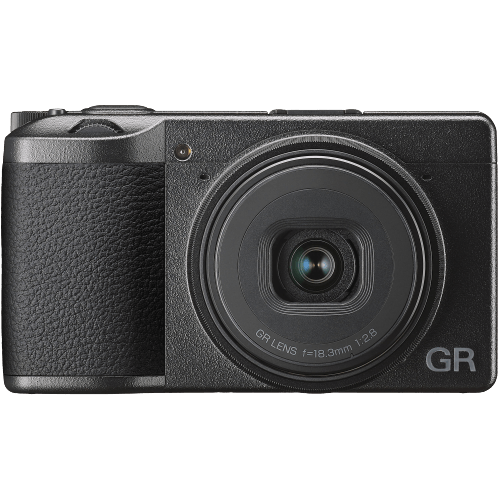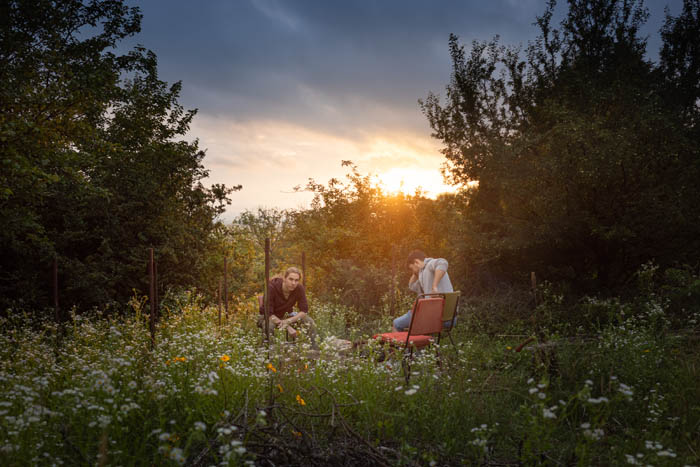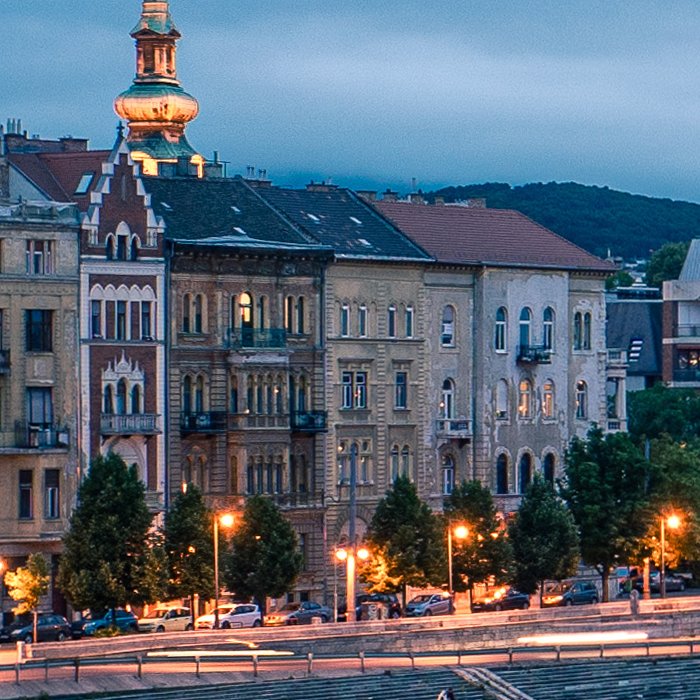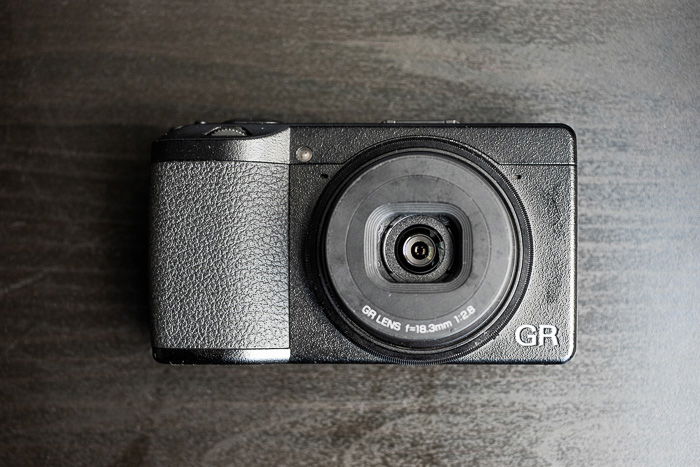This is where the Ricoh GR III comes in. So take a look at our review of this well-liked compact camera and see if it’s what you need.
Ricoh GR III Overview and Specifications
It has a non-removable lens that extends when turned on and slides back in the body when off. Its controls are somewhat similar, too, although only at first glance. An outsider eye couldn’t tell the difference between the GR III and an everyday, $100 compact camera. That’s where its power lies. In a small and dull-looking package, the camera gives you the possibilities and quality of an advanced mirrorless. This makes it ideal for scenarios where you’re better off remaining inconspicuous as a photographer. It is primarily for street photography. But it also finds its way into concerts, travel, and many more genres.
Key Features
Let’s take a closer look at the camera’s main selling points, as well as general qualities.
The Sensor
The Ricoh GR III has a 1.5x APS-C-sized sensor. It is, as far as I know, the smallest camera ever produced with such a large sensor. Its resolution is 24 megapixels, in a 3:2 aspect ratio, which means 6000×4000 pixels. This sensor is most likely manufactured by Sony, and very similar to the one found in the A6400. It offers excellent dynamic range. My main camera is a Canon 5D MkIII – a top-tier, full frame workhorse, once one of Canon’s flagship models. The sensor in the Ricoh GR III is on par with it, and outperforms it in some respects, such as shadow detail or noise quality. Shadows can be pulled up by quite a drastic amount without losing much detail. Highlights can be pulled back by almost 2 stops at base ISO without clipping. The RAW images you get from the GR III are on par with the best. ISO performance is also impressive. At ISO 3200 you still get lots of detail with noticeable, but not distracting noise. At ISO 6400 and 12800, noise becomes more aggressive, but the images are still very workable, especially with proper noise reduction. The quality of noise of the GR III is surprisingly great, though, more film-like than in any APS-C camera I’ve used. Often I find myself not reducing noise at all, because it adds to an image. ISO 25600 is where I’d stop using the GR III – at this point, images are either a noisy mess or a blurred mess because of the reduction.
Sensor Stabilization
A very important addition to the sensor is the 3-axis stabilization. I’ve found it to be very effective. I could always hand-hold a shutter speed of 1/10s and not get any blur due to handshake. On some occasions, I was able to achieve tack-sharp shots at around 0.5s. This option is called Shake Reduction (SR) in the menu. With the implementation of SR, Ricoh removed the anti-aliasing filter. This, together with the excellent lens, is responsible for the very sharp images you get. In situations where moiré is a threat, SR is turned on and acts as a filter. While it works miraculously with photos, I had trouble working with SR in video mode. While I was testing the GR III, I shot visuals to be used with my band on shows (yeah, back when we had shows). This involved shooting on moving vehicles, buses, trams and ships. When the vehicle accelerated, the stabilization system would try to counteract the movement by moving the sensor (and thus the image) to one side. This is normal and expected. However, when it reached the limit of correctable movement, it simply jumped back to the middle, resulting in a very sudden shift of framing. This ruined several takes, so after a while, I simply didn’t use it.
The Lens
The lens you’ll find on the GR III is an 18.3mm f/2.8 lens. It is equivalent to a 28mm f/4 lens in full frame measures. It’s very sharp and contrasty, as good as you’d expect a similar, professional lens on a DSLR to be. It fully utilises the 24MP pixel count of the sensor. Even when further upscaled digitally, photos remain outstandingly detailed. This combo allows for extensive cropping or large prints. I’m not sure if there isn’t distortion correction baked into the RAW files. It seems, anyway, that the lens is largely free of distortion. The lens is capable of impressive, almost macro close focusing. If you switch on macro mode (which you can do by pressing a separate button), it focuses as close as 6cm. Image quality remains stellar in this setting, too. I’ve found it to be very useful.
Optional Wide-Angle Adapter
As an extra, you can purchase a wide-angle filter. It converts the view from 28mm to 21mm. This accessory makes the camera significantly larger. However, it’s ideal for tighter scenes, landscapes, and potentially selfies as well.
Focusing
A heavily advertised feature of the Ricoh GR III is its focusing system. For the first time in the large-sensor GR line, it employs on-sensor phase-detection autofocus along with traditional contrast detection. Focusing points cover almost the entire sensor. Thanks to the fixed-lens construction, engineers were able to optimize it better than you’d expect in an average mirrorless camera. The AF system works like a charm, it’s snappy and accurate. Even in low light, I’ve found it hard to misfocus with the GR III, although it was considerably slower. A signature function of the GR series is the Snap Focus feature. It allows you to set a predetermined focus distance, and activate that at the press of a button. Essentially, it’s a sped-up way to do zone focusing. It’s quicker and more reliable than any autofocusing system currently on the market, although it definitely has a learning curve. This feature, again, makes the camera a very compelling choice for street photography. In a street scene, getting your subjects in focus is often a hit-and-miss process. An advanced system like this one increases your success rate noticeably.
Video Features
The GR III shoots up to 1080P footage at 60fps (at 8 bit, 4:2:0, if this means something to you). It’s usable, let’s say it like that. The colors are truly nice, stabilization helps a lot with smoothing out your hand movement, and focusing is accurate. However, in most settings, including 1080p/60, it’s very soft. Many reviewers on the internet have complained about the lack of 4K recording. To be fair, most people buying this camera probably won’t use it for shooting video, especially in a context where 4K is necessary. However, in a new camera from 2019, I, too, would consider this a basic feature. Another drawback is that while the camera offers full manual controls when taking stills, you can only shoot video in P mode. So, if you’re planning to shoot more-than-casual video with your new street photography camera, the GR III is not your choice.
Special Features
Unlike conventional cameras, which have curtain shutters, the GR III uses a leaf shutter. This makes it possible to use normal flash throughout the entire shutter speed range. You’re not limited by the sync speed. However, you’ll need to get an external flash for this – there’s no built-in flash in the camera. There is also a 2-stop ND filter included. It’s useful for slowing down your shutter speed for videos, as well as for using a wide aperture in bright daylight.
Body and Handling
The GR III is built to be very small, but pretty tough. It’s constructed of sturdy magnesium alloy and high-quality plastic. It feels solid in the hands and has a comfortable, albeit still small grip. One thing you’ll notice instantly is something wobbling inside the camera when it’s turned off. It took some time to figure out whether this was normal, but it absolutely is, and all GR IIIs behave like this. It’s actually just the stabilization system floating freely. This even protects the system from larger shocks. The body is 109mm wide and 62mm tall – not much larger than a smartphone. Its weight is 257g. The controls on this camera are great. There dedicated are buttons for every important setting, such as burst mode, white balance, macro mode, and more. A fully-fledged mode dial is located on the top, with manual mode, priority modes and three user-configurable modes. There are two control dials and an adjustment lever. This is a wonderful thing, and truly surprising to see in a camera of such small size. It would be great if we could set it up quick manual operation, using a separate dial for aperture, shutter speed, and ISO. Currently, even though the facilities are there, you can’t map ISO to any of the dials directly. A firmware update could solve this. A serial issue, covered by unlimited manufacturer warranty, is that many GR IIIs have a slightly wobbly main dial. The one I tested has indeed had this problem, but I didn’t find it distracting at all. On the back, you’ll find a 3” touchscreen, in a 3:2 aspect ratio. It’s colorful and detailed, but I’ve found it to be not bright enough in some situations. The menu system is fairly simple and optimised to be used with the touchscreen. A painfully missing feature is some level of weather sealing. This is evident from the construction of the camera. There’s a large gap between the lens and the extended lens housing, where water and dust will easily get into. This is probably the single most important disadvantage of the GR III. I personally love shooting in the rain, and many photographers do. Street scenes get a very different vibe on a rainy day. I’d love to capture that with the GR III, but the lack of sealing makes it very hard. Battery life is also not quite impressive, at 200-odd shots per battery on average. But you can always carry an extra battery or charge the camera via the USB-C port, so I wouldn’t consider this a large problem. The GR III can house a standard UHS-I SD card. However, if you’ve just left that at home, don’t worry – there is also 2GB of built-in storage. This is a rare, welcome feature. Also, the camera shoots raw files in DNG format. You can quickly transfer them to your phone via Wi-Fi and edit them in Lightroom Mobile.
Alternatives
The GR III has several alternatives. One of them is its predecessor, the Ricoh GR II. Now available for a reduced price, it shares most design elements with the third generation, including a very similar lens. It also has a built-in flash, which the GR III doesn’t have. However, it offers significantly less resolution at 16MP. Its sensor is not stabilised, which makes the f/2.8 lens much less appealing in low light. Another key difference in favour of the GR III is the autofocus system. While still better than most similar AF systems, the GR II’s contrast-detection-only solution is much slower in comparison with the GR III’s hybrid one. Another viable alternative is the Fujifilm X100F. It’s a compact camera, too, albeit built with a very different philosophy. It’s larger, heavier, and slightly more expensive. In a rangefinder-style body, it houses similar features: fully manual controls, a 24MP, but unstabilised sensor, while remaining fairly inconspicuous with its retro look. A key difference is the lens. The X100F utilises a 23mm f/2 lens. It’s tighter, equivalent to a 35mm view on full frame (vs 28mm on the GR III), but also a stop faster.
Conclusion
The Ricoh GR III is a fantastic little camera for a niche of photographers. It’s not limited to street photography overall. You can very much use it in any casual and documentary situation where you don’t need to zoom. It’s not cheap, and it’s not really versatile because of its prime lens. But it offers exceptional image quality, a very user-friendly build and interface, fast response, and a discrete exterior. All of this fits comfortably in your pocket. The only thing preventing it to be the perfect casual camera is the lack of weather sealing. But if you’re comfortable with that, you’ll be rewarded with great user experience, and thus great images. Update: I like this little camera so much that I decided to purchase one. So far, it has been a pleasant journey. I will update this post with a long-term review once I’ve used it for several months.
Scores














